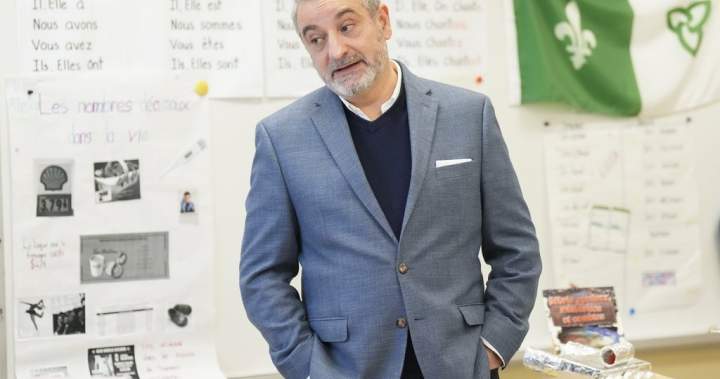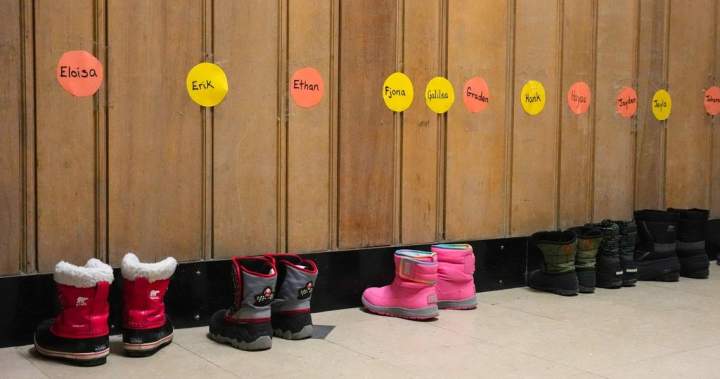Ontario won’t meet rural broadband target, partly due to cancelling Starlink deal

The Ford government will fail to meet its target of connecting unserved or underserved communities to reliable broadband by the end of 2025, Global News has learned, at least partly because of the premier’s decision to tear up a contract for Starlink internet.
In 2021, the province launched a plan to connect every household in Ontario to high-speed broadband, promising even the most remote communities would have access by the end of this year.
Now, though, with October ending, officials are accepting the target is no longer possible, indicating contract chaos from the Canada-U.S. trade war and construction delays are bogging down the plan.
The updated goal to connect everyone in the province to broadband is moving forward three years to 2028.
One of the reasons the goal needs to be moved, a source told Global News, is the ripple effect of Premier Doug Ford’s decision to scrap a $100 million contract with Elon Musk’s satellite Starlink internet service.
The now-defunct agreement between Ontario and SpaceX was first signed in November 2024 to provide satellite internet to roughly 15,000 homes in the north of the province.

Get daily National news
Get the day’s top news, political, economic, and current affairs headlines, delivered to your inbox once a day.
When tariffs were unveiled by United States President Donald Trump a few months later, however, Ford said he would retaliate by “ripping up” the agreement with Musk, who was then a central figure in the Trump administration.
“It’s done,” Ford said in March. “We’re not going back there, it’s done.”
The process of ripping up the contract proved more complicated than the premier had first indicated and ultimately resulted in Ontario agreeing to pay Starlink an undisclosed break fee.
Cancelling the agreement also had consequences for the province’s attempts to connect remote homes.
The government source, speaking confidentially, said there were no “feasible” alternatives to Starlink that the province could use. They said officials are working through other options, but none are yet ready.
Essentially, the source said, no other satellite internet options can take on the slack left by cancelling the Starlink deal, with alternatives like Rogers satellite utilizing Musk’s company’s resources.
The broadband plan has also met with construction delays in remote parts of the province.
Many of the physical broadband expansion plans are in the hardest-to-reach parts of Ontario, with contractors encountering setbacks laying the fibre optic cables required to bring the rural areas online.
In a bid to boost those projects, a new regulation will take effect tomorrow, allowing internet companies to more easily piggyback on hydro poles across the province.
That, the government hopes, will save time by allowing fibre cables to be quickly installed on existing infrastructure, rather than having to blast through rockface to bury them or install separate internet poles across the north.
If, with the new measures in place, delays with construction persist, the government may re-contract the work to meet its new 2028 timeline. The source said conversations around that were still in their early stages and stressed many projects were still proceeding at a decent pace.
While Ontario will fail to hit its 2025 target, the government said it stood by the overall goal. The new deadline to offer widespread rural internet is now set for halfway through 2028, and officials insist progress is being made.
More homes, they say, will be connected at the end of this year than before, and the almost $4 billion internet expansion remains the largest in the country.
When the government first announced its plan in 2021, it said as many as 700,000 households lacked access to high-speed internet or had no broadband access at all.
© 2025 Global News, a division of Corus Entertainment Inc.


More than 44,000 people showed up to the Rogers Centre on Halloween night, most of them dressed up in Toronto Blue Jays jerseys, primed for a party that instead turned into the baseball equivalent of a horror film.
The torture of a ninth-inning rally that was snuffed out almost as soon as it started ended in a 3-1 Dodgers victory in Game 6 that sends the Fall Classic to the terrifying do-or-die Game 7 in Toronto.
The anatomy of the rally-that-wasn’t will be something that Jays fans won’t want to think about for a while. It began with Alejandro Kirk getting hit by a pitch, and then Addison Barger launched a rocket to left field that, when it landed, wedged into the base of the wall.
Instead of scoring pinch runner Myles Straw from first base and trimming the L.A. lead to one, the extremely random event of a ball stuck between fence and ground — you could watch years of baseball and never see that happen again — meant that the runners had to hold position at second and third base.
Los Angeles Dodgers’ Mookie Betts (50) leaps into the arms of Kiké Hernández (8) after Toronto Blue Jays’ Addison Barger, right, was forced out to end Game 6 of baseball’s World Series, Friday, Oct. 31, 2025, in Toronto.
AP Photo/Ashley Landis
Still, there were none out, and Dodgers manager Dave Roberts brought in starting pitcher Tyler Glasnow to save their season.
Using a starter was incredibly risky. Coming in with two runners in scoring position is not what those guys do. But it paid off almost instantly.
Ernie Clement popped up on the first pitch, and Andres Gimenez hit a shot to left field that was caught — and with Barger straying too far from second base, he was thrown out for a double play that ended the game.
Instead of bursting with joy, the Rogers Centre was stunned into silence. Bring on the two most excruciating words in sports: Game 7.

Get breaking National news
For news impacting Canada and around the world, sign up for breaking news alerts delivered directly to you when they happen.
It will be a stomach-churning situation for both teams and their fans.
The Dodgers, the defending World Series champions with the biggest payroll in baseball, who had sailed through the playoffs before meeting the Jays, will be trying to avoid stumbling at the final hurdle.
And the Blue Jays, after a season that has so far exceeded all expectations, will be trying to avoid losing two straight at home to blow a 3-2 series lead. Despite a 54-27 regular season record at the Rogers Centre, Toronto is just 3-4 there over the last two playoff series.
This is the thing about a Game 7: It’s not just that you are hoping to win, it’s that you are desperate to escape the heartbreak of a loss when victory was so close.
Jays fans can take a bit of solace in the possibility that their team has the Dodgers right where they want them.
This is a team that has embraced its underdog status all season, that has told anyone who would listen that it had a deep trust in each other, with its roster full of scrappy baseball lifers and a handful of stars.
They came back from 0-2 down against Seattle in the ALCS, and bounced back again after a dispiriting Game 5 loss.
In the World Series, they found a way to pick themselves up after a brutal, 18-inning loss in Game 3 that would have left most teams reeling and won two straight in Los Angeles.
That is, they have a history with this kind of thing.
Before the shot-to-the-heart finish of Game 6, the original spoiler was set up to be Dodgers starting pitcher Yoshinobu Yamamoto, who, for the second time in the World Series, shut down what has otherwise been a potent Jays offence.
Yamamoto, the 26-year-old Japanese star, scattered five hits and struck out six with his dazzling array of pitches. He was also aided by a pair of double plays that snuffed out potential Toronto rallies.
The game had started with fireworks for the Blue Jays, even though they did not begin the game at the plate.
Kevin Gausman struck out freak-of-nature Shohei Ohtani to lead off the first inning and would go on to whiff five of the first six batters.
But his brilliant start hit a hiccup in the third inning, when Los Angeles outfielder Tommy Edman scorched a low liner into the right-field corner for a leadoff double.
After another Gausman strikeout, Jays manager John Schneider elected to put Ohtani, who has five extra-base hits in the series, on first base with an intentional walk.
The ploy backfired when Dodgers catcher Will Smith rocked a low fastball to left field for a run-scoring double.
After a walk to Freddie Freeman, Dodgers shortstop Mookie Betts came to the plate.
A former MVP who has spent most of the playoffs looking like he has never before had a bat in his hand, Betts rapped a single to left field for a two-run single.
It was almost cruel to Gausman. Los Angeles had bunched their three hits — the only hits that Gausman surrendered over six sterling innings — and came away with three runs.
Against a pitcher in the form that Yamamoto has been in for the postseason, which included back-to-back complete games, three runs felt like an awful lot.
Gausman, who has been Toronto’s most consistently dominant pitcher since summer turned to fall, continued his hard-luck streak.
He couldn’t get the win in either Game 1 or Game 5 of the American League Championship Series against Seattle, despite strong starts both times, and in the World Series, he has run up against Yamamoto twice. It has been the pitching equivalent of trying to fight a bear.
The Jays had their chances after Yamamoto left the game before the seventh inning. With two runners on in the eighth, a Bo Bichette pop-up and Daulton Varsho snuffed out the rally.
That disappointment was much less crushing than the one that would follow. In the ninth, the Jays were a base hit away from a tie game. And then it was over.
On Halloween, it was like a sorcerer had snapped their fingers. Comeback done.
And so, instead of a series-clinching celebration in Toronto, the Blue Jays will have to do it all over again on Saturday night, one last shot at what would be a most improbable championship.
They are, if nothing else, a team that does not seem to know when or how to quit. Their whole thing is wearing out opponents.
How fitting, then, that they are taking the World Series to the distance, and one last chance to end up in the spot that, six months ago, no one imagined they would be.

Ontario’s education minister has ordered a North Bay area school board to take immediate steps to resolve what a report described as overwhelming dysfunction or he will take “further action.”
Paul Calandra’s warning to the Near North District School Board comes after he placed five other boards under government supervision, and he is considering broad school board governance changes including eliminating the role of trustees.

Get daily National news
Get the day’s top news, political, economic, and current affairs headlines, delivered to your inbox once a day.
Calandra tasked a senior ministry bureaucrat with a review following media reports and parent concerns about problems at the board, and she submitted the report last month.
The report found that there is a “deficit of leadership” from the director of education and a fractured relationship between the administration and trustees, who themselves are divided and largely lack experience and knowledge of good governance.
The report says that dysfunction is partly to blame for a long-delayed opening of a new school in Parry Sound that has angered parents and students.
The board, through a spokesperson, declined to comment.
© 2025 The Canadian Press
Vaccine records aren’t up to date for more than half of Ottawa, Toronto students assessed: public health

Public health records for Ottawa and Toronto schools show that among the cohorts assessed this year, more than half of the students did not have up-to-date immunization records, which experts say exposes an antiquated system that’s unhelpful in the race to boost vaccination rates.
Toronto Public Health said it sent 60,000 letters over the summer to students in Grades 2 to 5 who hadn’t submitted records. The Immunization of School Pupils Act requires students to be vaccinated against nine diseases in order to attend school.
The public health unit said earlier this month about 54 per cent, or 50,000, students were still non-compliant, and would get suspension notices if their records aren’t updated in the coming months.
Similarly in Ottawa, the city’s public health unit said as of Oct. 12, about 16,000 students’ immunization records were not up to date in Grades 2 and 12. That’s more than 66 per cent of children in those age groups.
In Ontario, it’s up to parents to submit immunization records to public health units, which also send letters to households that haven’t done so or applied for exemption. Each year, local public health units select cohorts to assess for compliance.
Toronto Public Health said that in some grades, as few as 25 per cent of students have up-to-date vaccination records. It’s a particular problem among elementary school students.
Public health experts say the magnitude of students receiving these letters reflects that the cumbersome multi-step process, which often involves tracking down yellow cards or printouts from doctors’ offices, means public health officials have incomplete data.
“It’s not the ideal process and it is not what we would like to see happen,” Toronto’s Medical Officer of Health Dr. Michelle Murti said in an October interview at Metro Hall.

Get daily National news
Get the day’s top news, political, economic, and current affairs headlines, delivered to your inbox once a day.
This comes at a particularly critical time for Canada, which is seeing vaccination rates slide as health experts tackle misinformation online. Canada is also poised to lose its status as a measles-free country due to an ongoing yearlong outbreak that has infected more than 5,000 people over the past year.
If it does lose the status – which would happen later this year after meetings by the Pan American Health Organization – Canada would need to prove vaccination rates have improved to 95 per cent or higher and that it has robust surveillance to identify and contain cases in order to get its elimination status back.
Murti said the ideal scenario would be that health providers input vaccination records straight into a central provincial or national registry, a system doctors have been calling on the province to establish for decades.
Ontario’s top doctor Kieran Moore joined this chorus of calls last month, but acknowledged that the challenge is integrating data from various health-care providers stored in different systems. The Ministry of Health has said it is working on a digital tool to give people access to their vaccine records and other personal health information, but an estimated timeline was not available.
“We’ve been screaming from the rooftops for years on this issue,” Murti said.
Dr. Milena Forte is familiar with the perils of the vaccine reporting system, both as a family physician and a parent in Toronto.
Earlier this month, Forte said a mother brought her kids in for an appointment after receiving a letter from Toronto Public Health stating her children were missing vaccines. But when Forte checked her records, she saw the kids were up to date.
“You can imagine all the paperwork and all the people involved,” Forte said. “In a stressed system, we’re using resources to duplicate tasks – that doesn’t make a lot of sense.”
Forte received one of these letters a couple years ago stating that her own child was missing vaccines and would get a suspension notice if records were not provided.
She was confident her kid was immunized and even recorded the date, but she still had to go through the process of calling her doctor and asking them to pull up the information in their system, and forward her documentation to the school and public health.
“It’s creating extra work and we could be using this time to counsel on other preventative health issues including things like vaccination,” Forte said.
Last year, Hamilton’s public health unit sent almost 22,000 letters to parents of students in Grades 8 to 12 and 1 to 3 about incomplete vaccination records, representing about 38 per cent of the pupils in those cohorts. About 6,400 were eventually suspended.
Toronto Public Health says in the ’24-’25 school year, 6,090 students were suspended for one day or more. More than 4,400 students were still suspended by the second day.
Joe Crampton, a father of two kids in Hamilton, said it’s “ludicrous” that there is not one consolidated record of all of this information.
“The way you’d expect this to work in a financial institution is that you would just grant access from one entity to look at the other entity. But you don’t do that. You type into a system from a handwritten yellow card, but if you can’t find a card, you’re in trouble,” said Crampton, who works in financial institution software.
Ottawa-based Dr. Kumanan Wilson has been advocating for a vaccine registry for close to two decades.
The challenge at hand has stayed the same, except he said one element has changed that could make a difference: the resurgence of vaccine-preventable diseases like measles.
“It’s something we never expected to see,” he said. “There may be perhaps a bit more of an urgency to approach this.”
© 2025 The Canadian Press
-

 Uncategorized5 months ago
Uncategorized5 months agoShop Proud, Eat Proud, Be Proud — Ottawa Canada Day Market This June 28th
-

 5 months ago
5 months agoRing of Fire road to bring prosperity to First Nation, problems for caribou: report
-

 5 months ago
5 months agoMeasles circulating in northeastern B.C. community, health officials warn
-

 5 months ago
5 months agoCanada’s world junior trial saw juries tossed, intense testimony. Here’s a recap
-

 4 months ago
4 months ago161 bricks of suspected cocaine found on truck trying to cross Canada-U.S. border
-

 5 months ago
5 months agoFormer major leaguer, Jays doctor Ron Taylor dies
-

 5 months ago
5 months agoJagmeet Singh apologizes for attending Kendrick Lamar concert after Drake calls him out
-

 5 months ago
5 months agoAnishinabek Nation chief says he briefed Ontario police on protests against Bill 5





